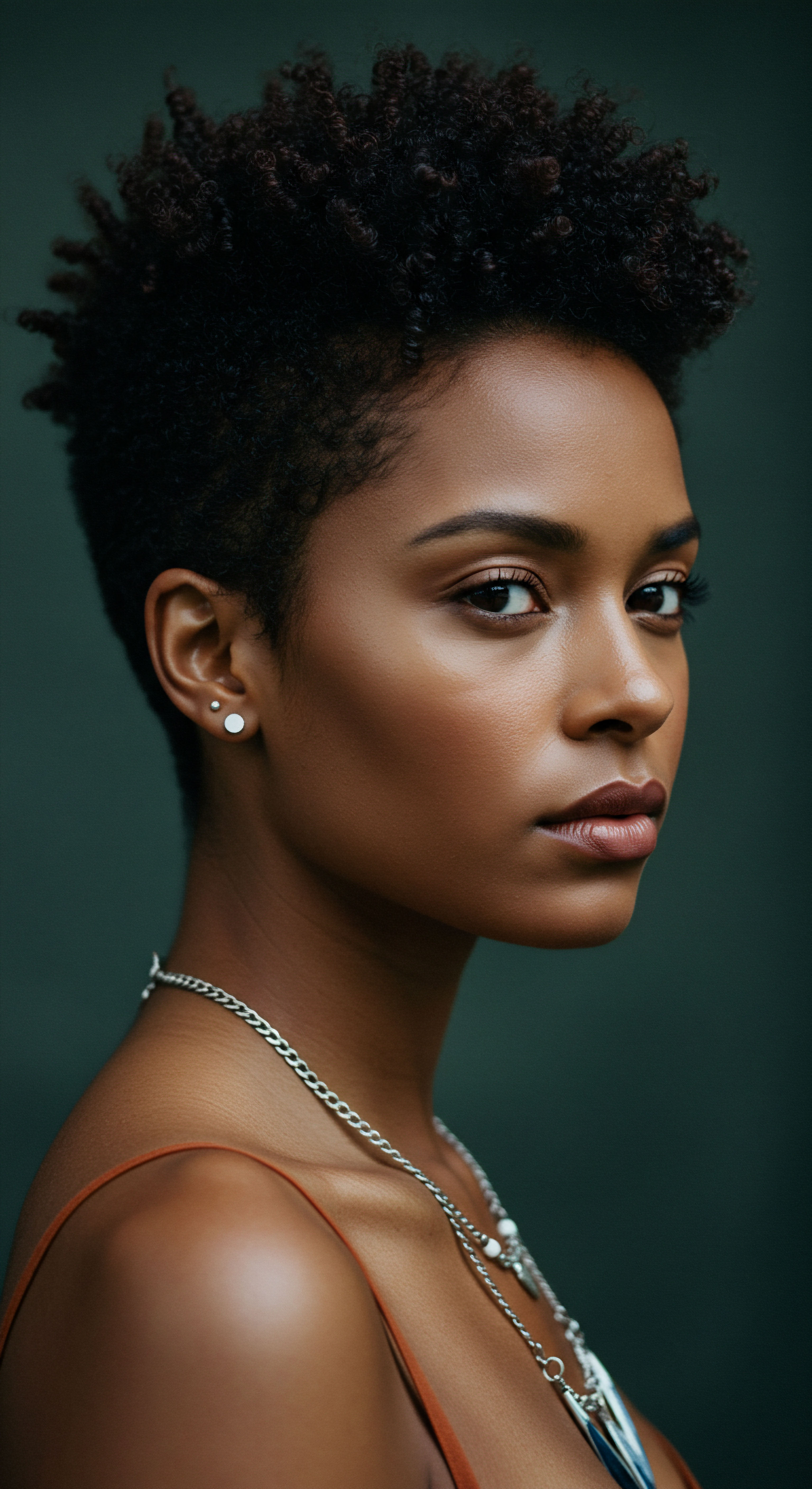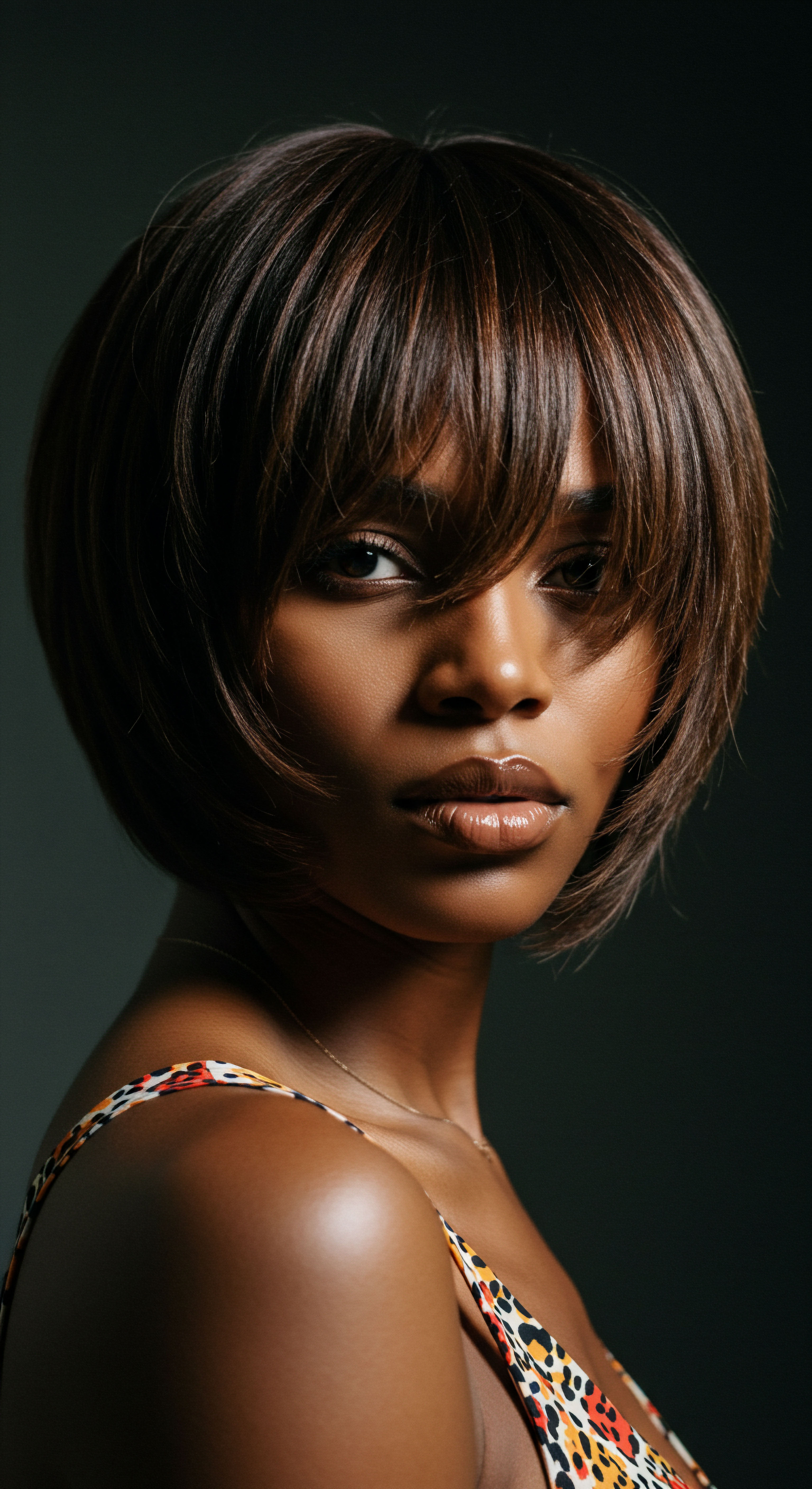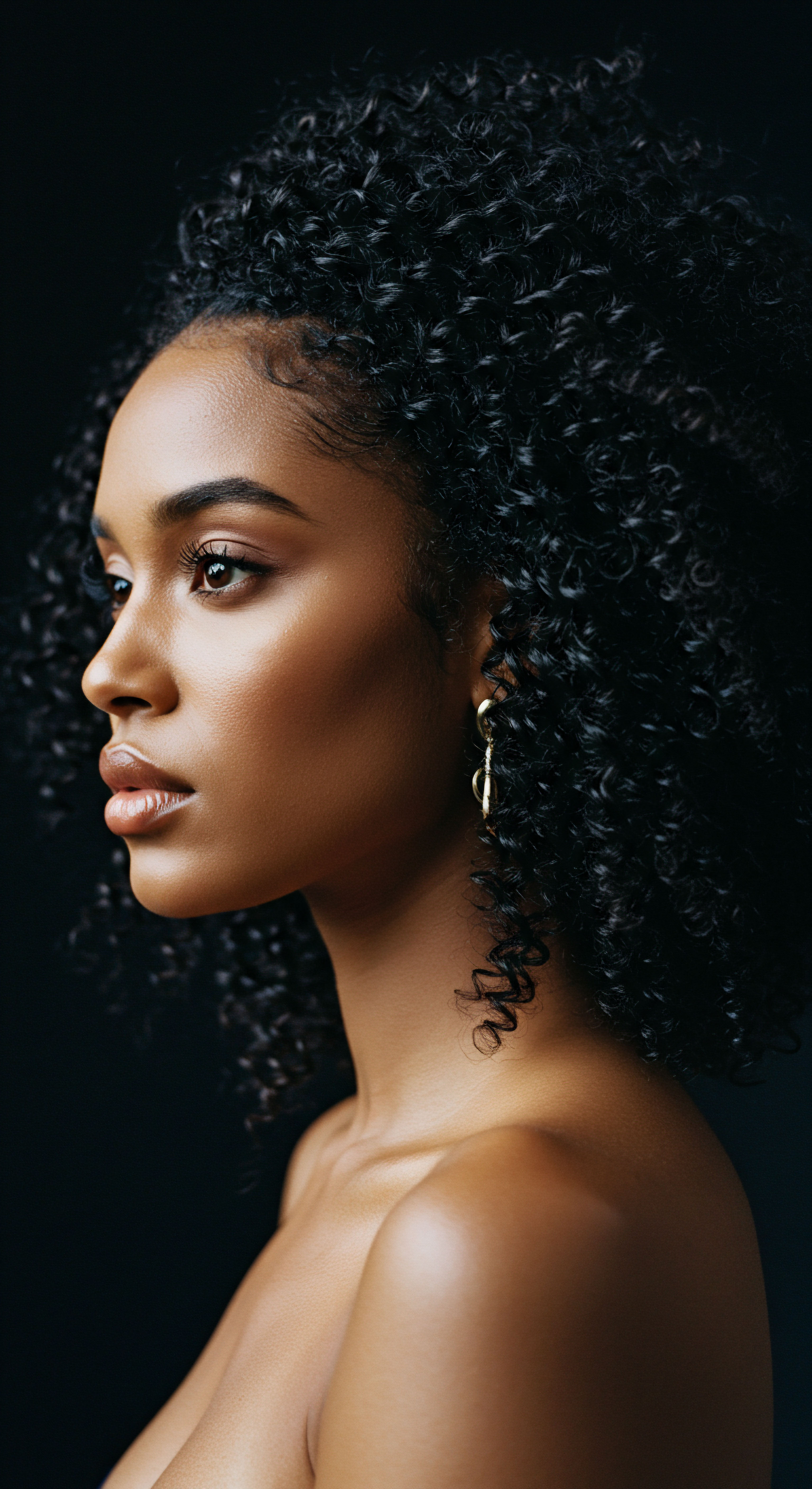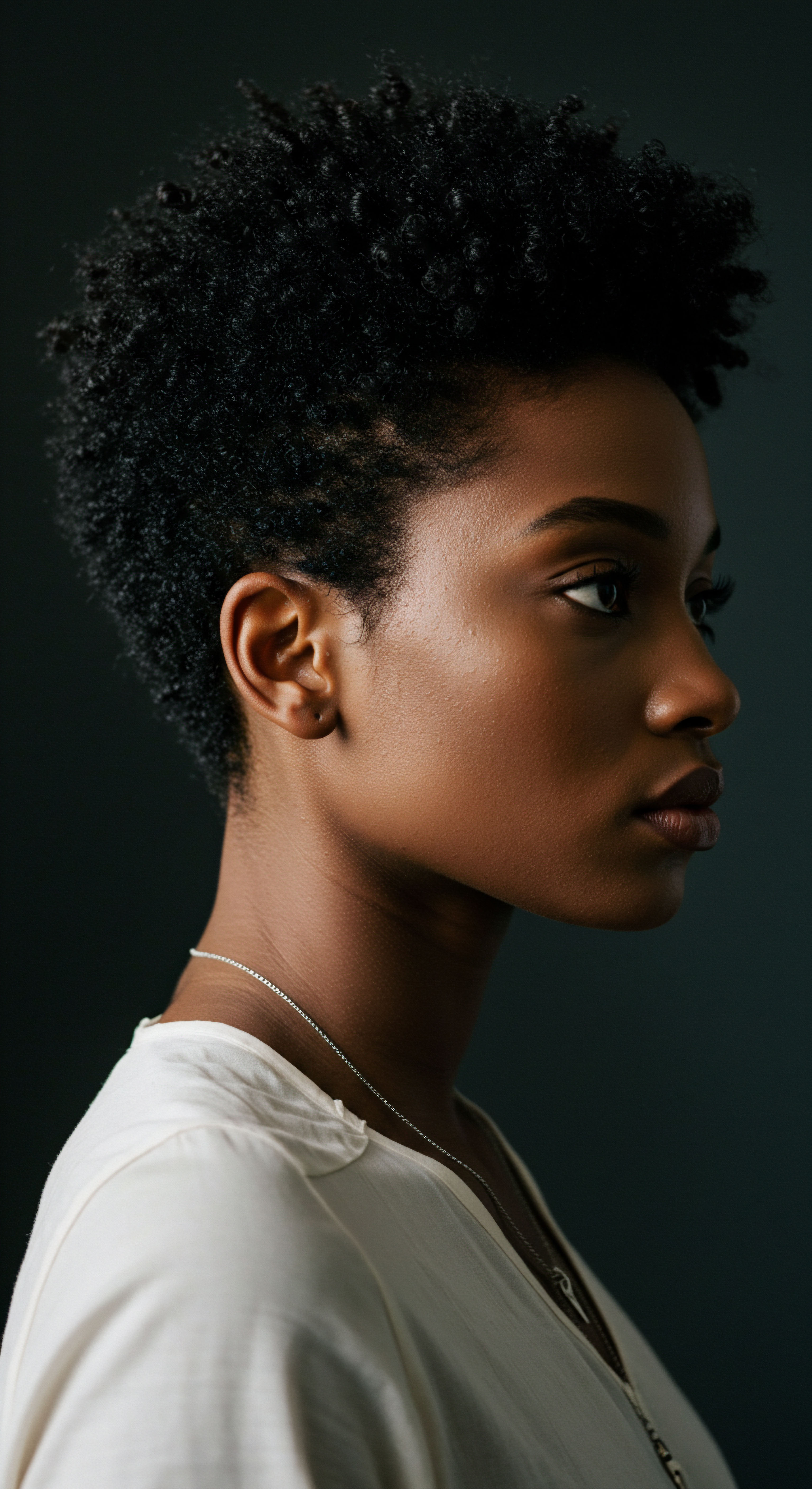
Roots
The very essence of our strands, those magnificent spirals and coils that grace our crowns, speaks volumes of stories untold. It is a story not only of genetic inheritance and styling practices, but of a profound connection to the earth’s bounty, a silent conversation between our internal landscape and the external display of vitality. For generations, before the advent of chemical concoctions and quick fixes, communities around the globe intuitively understood that the true strength and luminescence of hair began far beneath the surface, rooted deeply within the nourishment drawn from traditional plates. This journey into the foundational wisdom of diet and textured hair invites us to consider how ancient ways of eating might offer profound insights for modern hair well-being.
Consider the deep, resonant hum of health that flows when the body receives what it truly needs. For textured hair, with its unique structure and inherent inclination towards dryness, this internal symphony is particularly critical. Each strand, a testament to intricate biological design, relies on a steady stream of specific micronutrients and macronutrients to maintain its integrity, elasticity, and sheen. A diet rich in these elemental building blocks acts as a gentle, yet powerful, force, supporting the very cellular processes that give rise to vibrant hair.

What Foundational Elements Shape Hair Strength?
At its core, hair is primarily protein, a remarkable structure of keratin. This means that a consistent supply of high-quality protein is non-negotiable for robust strands. Traditional diets, often centered around whole, unprocessed foods, naturally delivered a diverse array of protein sources. Think of the communal meals, brimming with legumes, lean meats, fish, and ancient grains.
These offerings provided the necessary amino acids, the tiny architects that assemble each hair shaft. Without sufficient protein, hair can become brittle, dull, and prone to breakage, its natural resilience diminished.
Beyond protein, a constellation of vitamins and minerals contributes to the hair’s overall health. Iron, for instance, plays a crucial role in oxygen transport to the hair follicles, supporting their metabolic activity. Zinc aids in cell division and tissue repair, essential for consistent hair growth.
B vitamins, particularly biotin, are frequently lauded for their contribution to keratin production and overall hair health. These micronutrients, often found in abundance in traditional, unrefined food sources, work in concert, creating a synergistic effect that transcends the impact of any single nutrient.
The true strength and luminescence of textured hair often begin with the deep nourishment drawn from traditional dietary wisdom.
Traditional dietary patterns, unlike many modern approaches, emphasized nutrient density over caloric density. This meant that every bite was often packed with a wide spectrum of vitamins, minerals, and antioxidants, all contributing to systemic well-being, which in turn, reflected in the hair. The slow-cooked stews, the fermented foods, the diverse plant-based meals – these were not just sustenance, but intricate biological balancers.

How Does Ancient Dietary Wisdom Address Hair’s Unique Structure?
Textured hair, whether it be coily, kinky, or wavy, possesses a unique helical structure that makes it inherently more prone to dryness and breakage compared to straight hair. The twists and turns in the hair shaft create natural points of weakness and make it harder for natural oils from the scalp to travel down the entire length of the strand. This inherent characteristic means that the hair’s internal hydration and lipid balance become even more paramount.
Traditional diets often incorporated healthy fats from natural sources, which are vital for maintaining the lipid layers of the hair shaft and scalp. These fats, found in foods like avocados, nuts, seeds, and certain fish, provide the necessary building blocks for healthy cell membranes, including those within the hair follicle. They contribute to the hair’s natural sheen and suppleness, helping to mitigate the effects of environmental stressors and styling. The wisdom of these diets was not just about what was present, but also about the absence of highly processed ingredients, refined sugars, and unhealthy trans fats that can disrupt the body’s delicate internal equilibrium, potentially impacting hair health.
- Protein rich foods such as lentils, beans, and certain fish provided the essential amino acids for keratin.
- Healthy Fats from sources like olives, avocados, and seeds contributed to scalp health and hair sheen.
- Vitamins and Minerals found in diverse fruits and vegetables supported cellular processes within the hair follicle.

Ritual
Stepping beyond the foundational understanding of nutrients, we arrive at the rhythmic pulse of daily living, the conscious choices that form a ritual of well-being. For textured hair, this translates into an understanding that dietary choices are not isolated events, but threads in a larger fabric of care. It is about how the consistent, mindful incorporation of certain foods transforms from a mere act of eating into a supportive practice for hair’s continued vibrancy. This section guides us through the practical application of traditional dietary principles, offering a gentle hand in navigating the culinary landscape for radiant strands.
Consider the daily plate as a canvas, upon which we paint a picture of internal health. For those with textured hair, this painting often needs richer hues of hydration and specific micronutrients. The traditional kitchen, in many cultures, served as a pharmacy, where food was both sustenance and medicine. This holistic perspective, where food is viewed as a means to maintain balance and prevent imbalance, offers a profound framework for approaching textured hair vitality.

How Do Dietary Patterns Influence Scalp Health?
The scalp, the very ground from which our hair springs, is a living ecosystem, deserving of thoughtful attention. Its health directly impacts the strength and growth of each strand. Traditional diets often emphasized foods that supported a healthy inflammatory response and robust circulation, both critical for a thriving scalp.
For instance, the regular consumption of omega-3 fatty acids, abundant in certain fish and seeds, can help soothe an irritated scalp and reduce flakiness. These dietary components contribute to the integrity of the skin barrier on the scalp, protecting it from external aggressors and maintaining its delicate microbiome.
A compelling illustration of diet’s influence on scalp and hair health can be found in the case of individuals following traditional Mediterranean eating patterns. A study published in the journal Nutrients (2018) observed a correlation between adherence to a Mediterranean diet and a reduced risk of androgenetic alopecia (pattern hair loss) in women. While this study focused on hair loss rather than texture vitality specifically, it underscores the systemic impact of dietary choices on follicular health, suggesting that the anti-inflammatory and antioxidant-rich nature of such diets creates a favorable environment for hair growth and retention, which can only aid overall vitality. The principles behind this, such as ample fresh produce, healthy fats, and lean protein, resonate deeply with the needs of textured hair.
Consistent, mindful dietary choices form a supportive practice for textured hair’s continued vibrancy.
Hydration, too, plays a pivotal role in scalp health. While topical hydration is often discussed, internal hydration, derived from water-rich foods and adequate fluid intake, is equally important. Traditional diets, with their emphasis on fresh fruits, vegetables, and broths, naturally contributed to the body’s overall fluid balance, ensuring that the scalp remained supple and well-nourished from within.

What Traditional Foods Support Hair’s Moisture Balance?
Textured hair’s inclination towards dryness necessitates a focus on foods that support the body’s natural moisture retention mechanisms. Foods rich in silica, a trace mineral, contribute to the formation of collagen, a protein that provides structure to hair, skin, and nails. Oats, barley, and certain vegetables like cucumbers and bell peppers are good sources of silica.
Furthermore, vitamins A and C are essential for the production of sebum, the natural oil produced by the scalp that acts as a conditioner for the hair. Sweet potatoes, carrots, and leafy greens are excellent sources of vitamin A, while citrus fruits and berries provide ample vitamin C.
Consider the role of healthy fats in maintaining the hair’s lipid barrier. These fats, often from sources like cold-pressed oils, nuts, and seeds, contribute to the hair’s natural elasticity and prevent excessive moisture loss. The ritual of preparing meals with these ingredients, perhaps incorporating a drizzle of olive oil over a fresh salad or a handful of walnuts in a morning porridge, becomes a quiet act of devotion to hair health.
| Nutrient Group Protein |
| Dietary Sources Legumes, Fish, Lean Meats, Quinoa |
| Benefit for Textured Hair Builds keratin, strengthens hair shaft, reduces breakage. |
| Nutrient Group Healthy Fats |
| Dietary Sources Avocado, Olive Oil, Nuts, Seeds |
| Benefit for Textured Hair Maintains lipid barrier, enhances sheen, promotes elasticity. |
| Nutrient Group Iron |
| Dietary Sources Spinach, Lentils, Red Meat |
| Benefit for Textured Hair Supports oxygen transport to follicles, aids growth. |
| Nutrient Group Vitamin A |
| Dietary Sources Sweet Potatoes, Carrots, Kale |
| Benefit for Textured Hair Aids sebum production, promotes scalp health. |
| Nutrient Group Biotin (B7) |
| Dietary Sources Eggs, Almonds, Sweet Potatoes |
| Benefit for Textured Hair Supports keratin production, overall hair strength. |
| Nutrient Group A diverse diet provides a synergistic effect for hair well-being. |
The mindful preparation and consumption of these foods, often passed down through generations, constitutes a ritual. It is not simply about consuming nutrients, but about participating in a legacy of wellness, where every meal is an opportunity to honor the body and its magnificent crown.
- Omega-3 Fatty Acids from fatty fish or flaxseeds can soothe scalp irritation.
- Silica-Rich Foods such as oats and leafy greens aid in collagen production for hair structure.
- Vitamins A and C found in colorful produce support sebum creation and scalp health.

Relay
The journey into understanding textured hair vitality through traditional diets moves now to a more expansive vista, one where scientific precision converges with cultural legacies. This is not merely a recounting of what to eat, but a deep exploration of the ‘why’ behind these ancestral dietary patterns, examining the intricate biological mechanisms and socio-cultural contexts that have historically supported the magnificent resilience of textured strands. We peel back layers, looking at the nuanced interplay of genetics, environment, and sustained nutritional practices that shaped hair health across generations.
To genuinely comprehend the power of traditional diets, we must consider them not as isolated culinary practices, but as integral components of a holistic way of life. These diets were often intertwined with specific agricultural practices, communal eating habits, and a profound respect for natural cycles. This deep contextualization allows us to appreciate how sustained dietary patterns, rather than transient trends, exerted their long-term beneficial effects on the body, including the hair.

What Are the Micro-Nutritional Signatures of Traditional Diets for Hair?
Beyond the broad categories of macronutrients, the true subtlety of traditional diets lies in their specific micronutrient profiles. Consider the often-overlooked role of trace minerals. Selenium, for instance, a powerful antioxidant, protects hair follicles from oxidative stress, which can compromise hair growth and quality. Traditional diets rich in whole grains, nuts, and certain seafood naturally provided this essential element.
Similarly, copper plays a role in melanin production, influencing hair pigment, and its deficiency can lead to hair changes. These are not isolated agents but work within a complex biochemical symphony.
The bioavailability of nutrients within traditional food systems also warrants attention. Many traditional preparation methods, such as fermentation, soaking, and sprouting, enhanced the digestibility and nutrient absorption of foods. For example, fermenting grains or legumes reduces phytate content, which can otherwise hinder the absorption of minerals like zinc and iron, both critical for hair health. This intentionality in food preparation, passed down through generations, ensured that the body could truly extract the maximum benefit from its sustenance.
Traditional diets, with their nuanced micronutrient profiles and preparation methods, supported hair health through a complex biochemical symphony.
Consider the vibrant pigments in traditional plant-based foods – the deep reds of berries, the rich greens of leafy vegetables, the bright oranges of root crops. These colors often signal the presence of powerful antioxidants and phytochemicals. Carotenoids, flavonoids, and polyphenols, abundant in such diets, combat free radical damage, which can otherwise degrade hair proteins and lipids, leading to weakened, dull strands. These compounds contribute to overall cellular health, creating an optimal environment for hair follicles to function effectively.

Can Dietary Inflammation Impact Hair Texture and Vitality?
A less commonly discussed but highly significant aspect of diet’s impact on textured hair is its role in systemic inflammation. Chronic low-grade inflammation, often fueled by modern processed diets high in refined sugars and unhealthy fats, can silently sabotage hair health. This inflammatory state can disrupt the delicate follicular cycle, leading to premature hair shedding, weakened strands, and a general decline in vitality.
Traditional diets, by contrast, were inherently anti-inflammatory. They were rich in whole, unprocessed foods, healthy fats (like those found in olive oil or fatty fish), and a diverse array of plant-based ingredients packed with anti-inflammatory compounds. The balanced omega-3 to omega-6 fatty acid ratio often seen in these diets also contributed to a more favorable inflammatory response within the body. This systemic calm provides a fertile ground for hair follicles to perform their functions optimally, supporting robust growth and maintaining the hair’s natural texture and strength.
A compelling research point supporting this connection comes from a study published in the Journal of Investigative Dermatology (2017), which explored the impact of dietary patterns on inflammatory markers and hair loss. While primarily focused on alopecia, the research underscored how diets rich in pro-inflammatory components could exacerbate conditions affecting hair follicles, thereby emphasizing the protective role of anti-inflammatory dietary approaches. This deeper scientific lens helps us understand that the benefits of traditional diets extend beyond simple nutrient provision; they shape the very biochemical environment in which our hair exists.
The cultural dimension of traditional diets also cannot be overstated. Food was often communal, shared, and celebrated, fostering a sense of well-being that transcends mere physical nourishment. The reduction of stress, often a silent antagonist to hair health, was an inherent byproduct of these collective practices. This intricate dance between physical sustenance and emotional well-being created a powerful synergy that reinforced overall vitality, visibly reflected in the hair.

Reflection
As we gently close this exploration, we carry with us not just a collection of facts, but a deeper resonance with the enduring wisdom of ancestral ways. The journey into traditional diets and their profound impact on textured hair vitality reveals a simple, yet powerful truth ❉ our hair, in all its magnificent forms, is a mirror reflecting the delicate equilibrium within. It reminds us that true radiance stems from a place of deep nourishment, a gentle harmony between body, spirit, and the earth’s generous offerings.
To honor our strands with thoughtful dietary choices is to participate in a timeless legacy of well-being, a quiet act of self-reverence that speaks volumes without uttering a single word. May this understanding illuminate your path toward vibrant, joyful strands.

References
- Ge, Z. Yang, W. Li, C. Liu, L. Wu, M. Yang, S. & Li, R. (2018). Mediterranean Diet and Androgenetic Alopecia ❉ A Case-Control Study in Chinese Women. Nutrients, 10(12), 1969.
- Goren, A. Shapiro, J. & Roberts, J. L. (2017). Dietary patterns and hair loss in women ❉ A cross-sectional study. Journal of Investigative Dermatology, 137(5), 1164-1166.
- Pollan, M. (2009). In Defense of Food An Eater’s Manifesto. Penguin Press.
- Price, W. A. (2003). Nutrition and Physical Degeneration ❉ A Comparison of Primitive and Modern Diets and Their Effects. Price-Pottenger Nutrition Foundation.
- Fallon, S. (2001). Nourishing Traditions ❉ The Cookbook that Challenges Politically Correct Nutrition and the Diet Dictocrats. NewTrends Publishing.
- Cordain, L. Eaton, S. B. Sebastian, A. Mann, N. Lindeberg, S. Watkins, B. A. & Brand-Miller, J. C. (2005). Origins and evolution of the Western diet ❉ health implications for the 21st century. The American Journal of Clinical Nutrition, 81(2), 341-354.